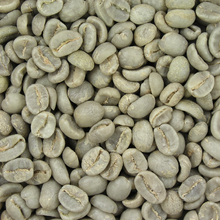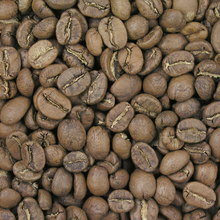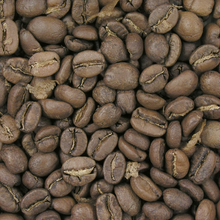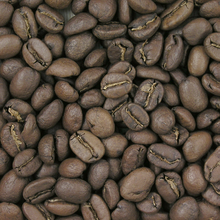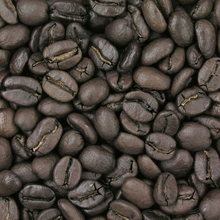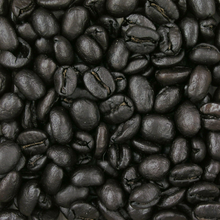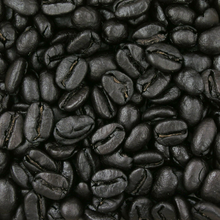- Coffee roasting
-
Roasting coffee transforms the chemical and physical properties of green coffee beans into roasted coffee products. The roasting process is what produces the characteristic flavor of coffee by causing the green coffee beans to expand and to change in color, taste, smell, and density. Unroasted beans contain similar acids, protein, and caffeine as those that have been roasted, but lack the taste. Heat must be applied for the Maillard and other chemical reactions to occur.
As green coffee is more stable than roasted, the roasting process tends to take place close to where it will be consumed. This reduces the time that roasted coffee spends in distribution, giving the consumer a longer shelf life. The vast majority of coffee is roasted commercially on a large scale, but some coffee drinkers roast coffee at home in order to have more control over the freshness and flavor profile of the beans.
Contents
Process
The coffee roasting process follows coffee processing and precedes coffee brewing. It consists essentially of sorting, roasting, cooling, and packaging but can also include grinding in larger scale roasting houses. In larger operations, bags of green coffee beans are hand or machine-opened, dumped into a hopper, and screened to remove debris. The green beans are then weighed and transferred by belt or pneumatic conveyor to storage hoppers. From the storage hoppers, the green beans are conveyed to the roaster. Roasters typically operate at temperatures between 240–275 °C (464–527 °F), and the beans are roasted for a period of time ranging from 3 to 30 minutes.[1] Initially, the process is endothermic (absorbing heat), but at around 175 °C (347 °F) it becomes exothermic (giving off heat).[2] For the roaster, this means that the beans are heating themselves and an adjustment of the roaster's heat source might be required. At the end of the roasting cycle, the roasted beans are dumped from the roasting chamber and cooled with forced air. Sometimes, in large commercial roasters, the beans are first quenched with a fine water mist. Torrefacto is a roasting process used in Spain and parts of Latin America involving the addition of sugar.
Equipment
The most common roasting machines are of two basic types: drum and hot-air, although there are others including packed bed, tangential and centrifugal roasters. Roasters can operate in either batch or continuous modes.
Drum machines consist of horizontal rotating drums that tumble the green coffee beans in a heated environment. The heat source can be supplied by natural gas, liquefied petroleum gas (LPG), electricity, or even wood. The most common employ indirectly heated drums where the heat source is under the drum. Direct-fired roasters are roasters in which a flame contacts the beans inside the drum; very few of these machines are still in operation.
Hot-air roasters force heated air through a screen or perforated plate under the coffee beans with sufficient force to lift the beans. Heat is transferred to the beans as they tumble and circulate within this fluidized bed.
Degree of roast
Coffee roasters use names for the various degrees of roast, such as City Roast and French Roast, for the internal bean temperatures found during roasting. Roastmasters often prefer to follow a "recipe" or "roast profile" to highlight certain flavor characteristics. Any number of factors may help a person determine the best profile to use, such as the coffee's origin, variety, processing method, or desired flavor characteristics. A roast profile can be presented as a graph showing time on one axis and temperature on the other, which can be recorded manually or using computer software and data loggers linked to temperature probes inside various parts of the roaster.
Determining degree of roast
The most popular, but probably the least accurate, method of determining the degree of roast is to judge the bean's color by eye (the exception to this is using a colorimeter to measure the ground coffee reflectance under infrared light and comparing it to standards such as the Agtron scale). As the beans absorb heat, the color shifts to yellow and then to increasingly darker shades of brown. During the later stages of roasting, oils appear on the surface of the bean. The roast will continue to darken until it is removed from the heat source. Beans will also darken as they age, making color alone a poor roast determinant. Most roasters use a combination of bean mass temperature, smell, color, and sound to monitor the roasting process.
Sound is a good indicator of bean temperature during roasting. There are two temperature thresholds called "cracks" that roasters listen for. At about 205–207 °C (401–405 °F), beans will emit a cracking sound much like popcorn does when it pops, only much quieter. This point is called "first crack," marking the beginning of light roasts. When the beans are at about 224–227 °C (435–441 °F), or a medium roast, they emit a "second crack." This is the dividing point between medium and dark roasts.
Degree of roast pictorial
These images depict samples taken from the same batch of a typical Brazilian green coffee at various bean temperatures with their subjective roast names and descriptions.[3][4][5][6][7]
22 °C (72 °F) Green Beans Green coffee beans as they arrive at the dock. They can be stored for up to two years.
165 °C (329 °F) Drying Phase As beans roast, they lose water and increase in size. Arabic coffee is prepared using this roast.
195 °C (383 °F) Cinnamon Roast The lightest drinkable roast, immediately before first crack. Light brown, toasted grain flavors with sharp acidic tones.
205 °C (401 °F) New England Roast Moderate light brown, still acidic but not bready, a traditional roast for Northeastern U.S. Coffee, at first crack.
210 °C (410 °F) American Roast Medium light brown, the traditional roast for the Eastern U.S. First crack ending.
220 °C (428 °F) City Roast Medium brown, the norm for most of the U.S., good for tasting the varietal character of a bean.
225 °C (437 °F) Full City Roast Medium dark brown with occasional oil sheen, good for varietal character and bittersweet flavors. At the beginning of second crack.
230 °C (446 °F) Vienna Roast Moderate dark brown with light surface oil, more bittersweet, caramel-y flavor, acidity muted. In the middle of second crack. Occasionally used for espresso blends.
240 °C (464 °F) French Roast Dark brown, shiny with oil, burnt undertones, acidity diminished. At the end of second crack. A popular roast for espresso blends.
245 °C (473 °F) Italian Roast Very dark brown and shiny, burnt tones become more distinct, acidity almost gone, thin body. The common roast for espresso blends.
250 °C (482 °F) Spanish Roast Extremely dark brown, nearly black and very shiny, charcoal and tar tones dominate, flat, with thin body.
Caffeine content by roast level
Caffeine content varies by roast level. Caffeine diminishes with increased roasting level: light roast, 1.37%; medium roast, 1.31%; and dark roast, 1.31%.[8] However, this does not remain constant in coffee brewed from different grinds and brewing methods.
Roast naming confusions
There is no such thing as an "espresso roast." Espresso is a beverage, not a temperature. Blends of beans intended for espresso are generally roasted from between Full City and Italian roast. In recent years, the term French Roast has been marketed as the name for a coffee blend or style. While appropriately roasted to French roast, it blurs the line between blend name and temperature.
Roast flavors
At lighter roasts, the bean will exhibit more of its "origin flavor"; the flavors created in the bean by its variety, the soil, altitude, and weather conditions in the location where it was grown.[9]
Coffee beans from famous regions like Java, Kenya, Hawaiian Kona, and Jamaican Blue Mountain are usually roasted lightly so their signature characteristics dominate the flavor. As the beans darken to a deep brown, the origin flavors of the bean are eclipsed by the flavors created by the roasting process itself. At darker roasts, the "roast flavor" is so dominant that it can be difficult to distinguish the origin of the beans used in the roast.
Below, roast levels and their respective flavors are described.[10] These are qualitative descriptions, and thus subjective. As a rule of thumb, the "shinier" the bean is, the more dominant the roasting flavors are.
Roast level Notes Surface Flavor Light Cinnamon roast, half city, New England After several minutes the beans “pop” or "crack" and visibly expand in size. This stage is called first crack. American mass-market roasters typically stop here. Dry Lighter-bodied, higher acidity, no obvious roast flavor Medium Full city, American, regular, breakfast, brown After a few short minutes the beans reach this roast, which U.S. specialty sellers tend to prefer. Dry Sweeter than light roast; more body exhibiting more balance in acid, aroma, and complexity. Smoother than the traditional American "medium" roast, but may display fewer of the distinctive taste characteristics of the original coffee.[11] Full Roast High, Viennese, Continental After a few more minutes the beans begin popping again, and oils rise to the surface. This is called second crack. Slightly shiny Somewhat spicy; complexity is traded for heavier body/mouth-feel. Aromas and flavors of roast become clearly evident. Double Roast French After a few more minutes or so the beans begin to smoke. The bean sugars begin to carbonize. Very oily Smokey-sweet; light bodied, but quite intense. None of the inherent flavors of the bean are recognisable. Home roasting
Main article: Home roasting coffeeHome roasting is the process of roasting small batches of green coffee beans for personal consumption. Even after the turn of the 20th century, it was more common for at-home coffee drinkers to roast their coffee in their residence than it was to buy pre-roasted coffee. Later, home roasting faded in popularity with the rise of the commercial coffee roasting companies. In recent years home roasting of coffee has seen a revival.[12] In some cases there is an economic advantage, but primarily it is a means to achieve finer control over the quality and characteristics of the finished product.
Packaging
Extending the shelflife of roasted coffee relies on maintaining an optimum environment to protect it from exposure to heat, oxygen, and light. Roasted coffee has an optimal typical shelf life of 2 weeks, and ground coffee about 15 minutes. Without some sort of preservation method, coffee becomes stale. The first large scale preservation technique was vacuum packing in cans. However, because coffee emits CO2 after roasting, coffee to be vacuum packed must be allowed to degas for several days before it is sealed. To allow more immediate packaging, pressurized canisters or foil-lined bags with pressure-relief valves can be used. Refrigeration and freezing retards the staling process. Roasted whole beans can be considered fresh for up to one month if kept cool.[citation needed] Once coffee is ground it is best used immediately.
Emissions and control
Particulate matter (PM), volatile organic compounds (VOC), organic acids, and combustion products are the principal emissions from coffee processing.[13] Several operations are sources of PM emissions, including the cleaning and destoning equipment, roaster, cooler, and instant coffee drying equipment. The roaster is the main source of gaseous pollutants, including alcohols, aldehydes, organic acids, and nitrogen and sulfur compounds. Because roasters are typically natural gas-fired, carbon monoxide (CO) and carbon dioxide (CO2) emissions result from fuel combustion. Decaffeination and instant coffee extraction and drying operations may also be sources of small amounts of VOC. Emissions from the grinding and packaging operations typically are not vented to the atmosphere.
Particulate matter emissions from the roasting and cooling operations are typically ducted to cyclones before being emitted to the atmosphere. Gaseous emissions from roasting operations are typically ducted to a thermal oxidiser or thermal catalytic oxidiser following PM removal by a cyclone. Some facilities use the burners that heat the roaster as thermal oxidisers. However, separate thermal oxidisers are more efficient because the desired operating temperature is typically between 650–816 °C (1202–1501 °F), which is 93–260 °C (199–500 °F) more than the maximum temperature of most roasters. Some facilities use thermal catalytic oxidizers, which require lower operating temperatures to achieve control efficiencies that are equivalent to standard thermal oxidisers. Catalysts are also used to improve the control efficiency of systems in which the roaster exhaust is ducted to the burners that heat the roaster. Emissions from spray dryers are typically controlled by a cyclone followed by a wet scrubber.
Gallery
See also
References
- ^ Davids, Kenneth. Home Coffee Roasting: Romance and Revival. St. Martin's Griffin; revised edition, November 2003. ISBN 978-0312312190. pp 125, 143.
- ^ Raemy A, Lambelet P. A calorimetric study of self-heating in coffee and chicory. Int J Food Sci & Tech, 1982;17(4):451–460.
- ^ Degree of Roast menu item at http://www.homeroasters.org/index.htm
- ^ http://www.sweetmarias.com/roasting-VisualGuideV2.php
- ^ http://www.coffeereview.com/reference.cfm?ID=26
- ^ http://www.coffeereview.com/glossary.cfm
- ^ Davids, Kenneth. Home Coffee Roasting: Romance and Revival. St. Martin's Griffin; revised edition, November 2003. ISBN 978-0312312190. p. 68.
- ^ Verlengia F, Rigitano A, Nery JP, Tosello A. Variations of the caffeine content in coffee beverages. ASIC, 2nd Int Sci Colloq Green and Roasted Coffee Chem. 1965, 106-114.
- ^ Spiller, Gene (9 October 1997). Caffeine. Los Altos, California, USA: SPHERA Foundation. p. 85. ISBN 9780849326479.
- ^ Thompson, Tom (2009). "An Updated Pictorial Guide to the Roast Process". http://www.sweetmarias.com/roasting-VisualGuideV2.php. Retrieved 12 Januari 2010.
- ^ "Full-City Roast, Light French Roast, Viennese Roast, Light Espresso Roast, City Roast, High Roast". http://www.coffeeglossary.net/F/full-city-roast-light-french-roast-viennese-roast-light-espresso-roast-city-roast-high-roast.html. Retrieved 8 September 2010.
- ^ Davids, Kenneth. Home Coffee Roasting: Romance and Revival. St. Martin's Griffin; revised edition, November 2003. ISBN 978-0312312190
- ^ http://www.epa.gov/ttn/chief/ap42/ch09/final/c9s13-2.pdf
External links
Categories:
Wikimedia Foundation. 2010.




